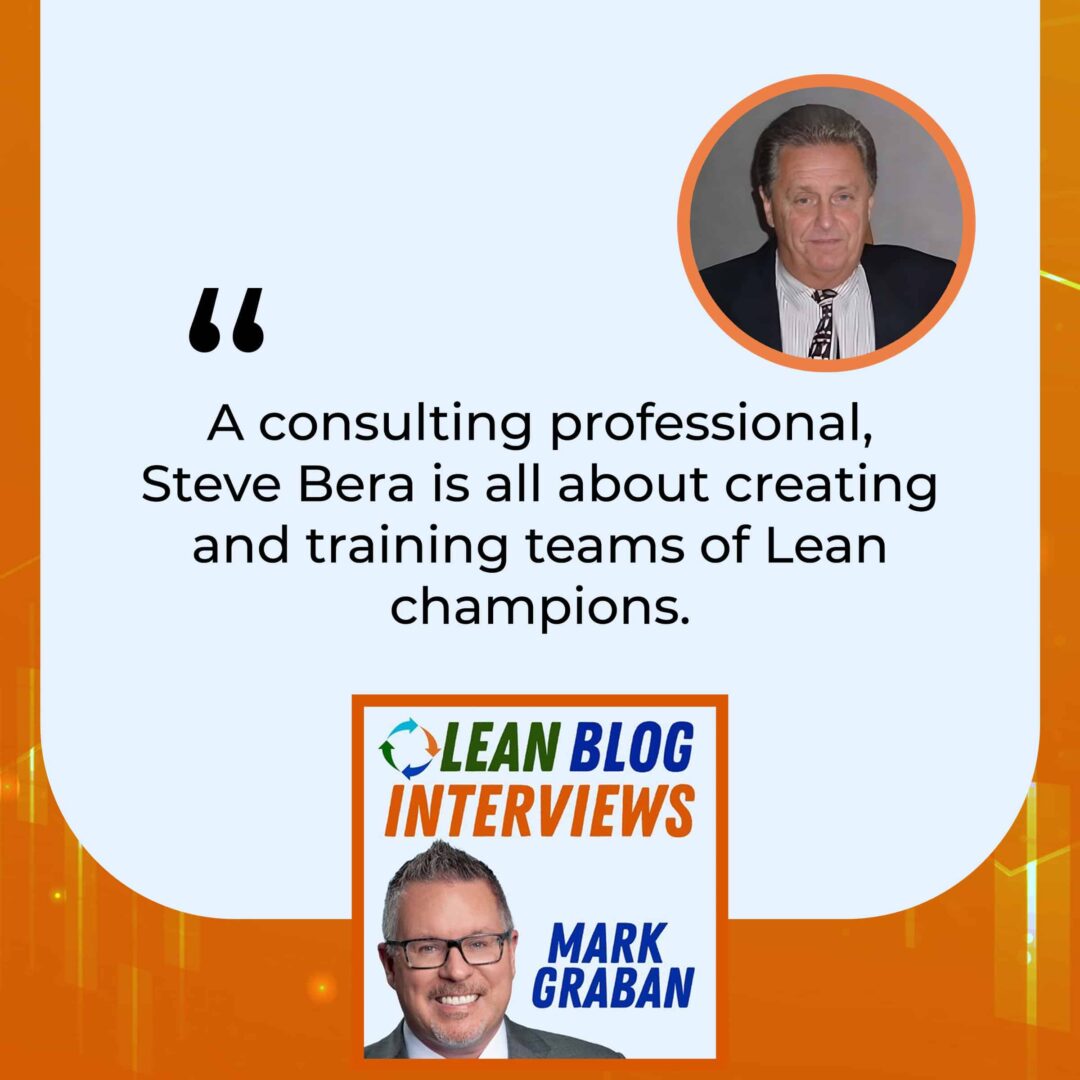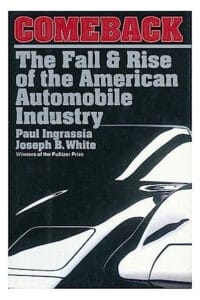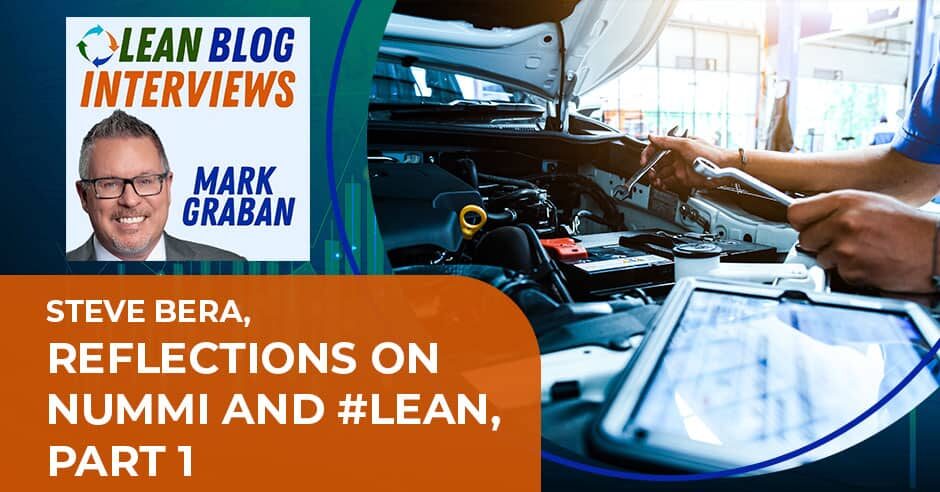I'm really excited to have Steve Bera as my guest for episode #256 of the podcast. I read about him as he was featured prominently in a chapter of the 1994 Pulitzer-Prize winning book Comeback: The Fall & Rise of the American Automobile Industry. I just finished it during my recent flight back from China.
The book is about the struggles of the Detroit automakers in the 1980s and early '90s. Steve was featured in the book as he was one of the first 16 GM managers and leaders to be sent to work with Toyota at the famed NUMMI joint venture factory in California. Steve was also part of the “This American Life” episode that looked back at the lessons from NUMMI. If you're not familiar with the NUMMI story, you might want to listen to that first.
He learned some amazing lessons from Toyota… but left GM after his two-year NUMMI stint, as he was concerned that he wouldn't be effective back within the traditional GM (you'll hear about that in Part 2). So, since then, Steve has worked as a consultant and leader in many industries, including some recent time working for large retailers, working to create Lean supply chains.
We had a very long chat, so I'm releasing two parts to this discussion in separate episodes (see also Episode #259). I am also sharing a transcript for the episode at the end of this post. I hope you enjoy the reflections as much as I did. You can also read a summary I wrote of the two posts on LinkedIn.
Topics Covered In This Episode:
- How did you get to be one of the 16 “NUMMI Commandos?”
- What lessons did you learn from Toyota and NUMMI about this different style of leadership?
- Any favorite stories about what was surprising about the NUMMI way?
- Why is a “no layoffs” philosophy so important, whether it was NUMMI or other organizations?
For earlier episodes of my podcast, visit the main Podcast page, which includes information on how to subscribe via RSS, through Android apps, or via Apple Podcasts. You can also subscribe and listen via Stitcher.
Thanks for listening!
What do you think? Please scroll down (or click) to post a comment. Or please share the post with your thoughts on LinkedIn. Don't want to miss a post or podcast? Subscribe to get notified about posts via email daily or weekly.
Listen to the podcast here
Steve Bera, Reflections On NUMMI And #Lean, Part 1

I'm excited to have Steve Bera as my guest for this episode. I read about him when he was featured prominently in parts of the 1994 Pulitzer Prize-winning book Comeback: The Fall and Rise of the American Automobile Industry. I read the first half of the book before the interview. That is what prompted me to reach out to him when we did this. I finished the book during my flight back home from my trip to China. It suggests the struggles of the Detroit automakers in the 1980s and early '90s and all of the egos and drama that were involved.
I learned about the book after a discussion about former GM CEO Roger Smith's obsession with robotics and factory automation. I was googling the $80 billion number, which is the amount Smith and GM spent on ill-fated automation attempts, and it led me to this outstanding book. Steve Bera was featured in the book because he was one of the first sixteen GM managers and leaders to be sent to go work with and learn from Toyota at the famed NUMMI Joint Venture Factory in California.
Steve was also part of the excellent episode of This American Life, the public radio show that looked back at the lessons from NUMMI. Steve learned some amazing lessons from Toyota but ended up leaving GM right at the end of his two-year NUMMI stent, as he was concerned he wouldn't be effective back within the traditional GM culture. You will hear about that in part two of our discussion in an upcoming episode.
Since then, Steve has worked as a consultant and a leader in many industries, including some recent time, spent working for large retailers and working to create Lean supply chains. I loved the conversation. I will be releasing two parts to this discussion. I hope you enjoy his reflections and the conversation as much as I did.
—
Steve, thanks so much for being a guest.
I appreciate the opportunity. Once again, I revisit a success story that has been for several years since NUMMI began and talked about it. It is something that I look forward to.
I'm sure there's a longer background to help introduce yourself, but how did you get to be one of what they called The 16 NUMMI Commandos?
At the time that I was being considered, I was in the GM building in their corporate production control group. I went there in 1979. 1982 and 1983 were when Toyota finalized the agreement with General Motors. They profiled all the individuals as far as their functional background and what they were looking for in terms of the type of people to help them start up the joint venture. They were looking for production control types, manufacturing, quality, finance, and marketing.
I was asked if I wanted to be considered for that, and I did. It wound up being an invitation to fly to California to be interviewed by a gentleman by the name of Mr. Uchikawa who became my manager. I flew out to California. I'm not quite sure how it all came about, but I didn't last longer than 30 minutes in my interview with him, and he had made his decision. Whatever questions he asked and whatever responses I gave seemed to go well. It wasn't until I returned back to Detroit that I was advised that I had been selected to participate as 1 of the 16 members to start up the joint venture.
In the books and articles about the group of you, you are labeled as high-potential managers. How competitive was it to get into that group? Was it semi-competitive? Were there lots of people dying for the opportunity? This was all new and uncertain.
What we didn't know was how many were in the queue in the selection process. I was one of the only ones that came out of the GM building in the production control group. Somewhere in the corporate structure, each department had identified their high potential individuals to be successful in joining Toyota. That decision would rest with Toyota, but they felt that based on my background in multiple areas of the corporation, I would have an opportunity to succeed if selected.
That term NUMMI Commandos wasn't the Wall Street Journal that later used that descriptor. It wasn't how you were describing yourselves at the time.
Paul Ingrassia and Joe White won the Pulitzer Prize for writing that book. They were the ones who wrote and coined the phrase NUMMI Commandos.
I recommend that book, Comeback. I was reading about Steve. A comment to the readers here, “Who am I to question Pulitzer Prize-winning authors?” It seemed like NUMMI Ninjas might have had a better ring to it, but maybe they thought that sounded too Japanese.

They did a great job of describing the storyline to everyone. When you think back about the word commando, that wasn't our role when we were out there. I almost feel like the term commando was supposed to be something once we were repatriated back into the corporation to be able to help drive change within General Motors.
We will come back to how that played out here in a little bit. Thinking about your early education in Japan, Toyota, and NUMMI, what were some of the early lessons that you learned about that different style of leadership compared to what you were used to at General Motors?
The sixteen of us were deep in our understanding of our own areas of expertise, whether it was production control, finance, or marketing. Everyone had an extensive background in that. The thing that I found when we went out there with the team who was going to be training us is they not only were deep in every aspect of their business. They were broad-based knowledge of everything. They could speak to the engineering, customer service, and financial aspects of the business. It was almost intimidating because we weren't raised that way in GM. You were good at what you did. That is what your performance was based upon. We found that we needed to broaden our own spectrum of understanding of the car business from one end of the business unit to the other.
The other thing that was critically important was the Toyota team was involved to an extraordinary depth of time where it wasn't where they were showing up and leaving. Their presence was everywhere in each one of our response areas of responsibility. Whether it was in the plant, office, or meetings, they were there to ensure that we were steering the ship in the right direction.
A lot of times, in our world, we think we know a lot. Sometimes our ego can get in the way of good judgment. I have used the word before. Humility is something each one of us learns at different points in our life. Humility is something that everyone learns quickly out there because they realize that we don't have all the answers. We weren't contemporary thinkers in terms of manufacturing in the car business, but they showed us over the course of the training where the gaps were and what we understood as far as the best practices. That was the Toyota production system.
A lot of times, in our world, we think we know a lot. Sometimes our egos can get in the way of good judgment. Share on XToyota leaders talk about the idea of leading with humility. There is a book called Toyota by Toyota that was written by a number of Americans who worked at the Toyota Georgetown Plant in Kentucky, which opened a few years after the NUMMI experiment started. The first chapter of that book focuses on leading with humility. My follow-up question for you is this. I have talked about this with people. I have always wondered, is humility somehow an ingrained trait where people have a certain level of humility? You said, “It can be learned.” Can you maybe elaborate on that a little bit?
Humility comes back from a reflection. You almost do a comparison against your peers and those around you. I have always looked at how I build my own portfolio. I look at those that have strengths and attributes in the way they conduct themselves, run their business, speak, and communicate. I took those attributes that they have that I feel will strengthen me. In some cases, maybe they had those characteristics that I didn't feel were good for me.
What amounted to is when I looked at my own portfolio after working with Toyota for the length of time that I was there, I realized that I was short from the standpoint of broad-based knowledge and understanding of how to not only lead people but to understand my business. I was trying to establish a paragon within myself and a model of excellence by which I had to abide by and was hopefully trying to emulate the performance of others around me.
It sounded like this broad base systems knowledge of functions and breaking down silos. How did that reflect in terms of how things, teams, individuals, and departments were measured and evaluated at NUMMI?
When we were at full strength, we had 2,100 team members and members of the management team. Every day, the only number that we were exposed to was, “How many cars we were supposed to build and how many did we build?” It was contrary to what I had been experiencing in my previous career because it was more of a deep dive. In other words, individual performances. How well did I score? How well did my department score?
As opposed to did we do things as an organization and a team to where it was a positive contribution to achieve the business objectives in the strategic direction of where we were going? The one thing that we all had to come to grips with was we all win and we all fail. There are measurement systems that would evaluate the individual, but it was not so much a numeric but more of a qualitative input into what we did to support the objectives of the business.
We all win, and we all fail. Share on XI'm breaking down the silos. I'm curious. You talk about the production volume number, which is important. In earlier parts of the book Comeback, and I remember from my time at GM, it was quantity, moving the metal, and making the numbers. There are stories in the book Comeback about how one silo in GM didn't want to help the car division. There were elements in those different stories of putting quantity before quality. What was the approach to finding the right balance in those metrics in NUMMI? Did Toyota assume you had to build the quantity, but they had to be built right the first time? Was that ingrained?
I recall my days when I was in the GM building. We would get on the elevator and go up to the fourteenth floor for a meeting with their key execs. On the wall of the elevator was, “How many cars and trucks were built the day before?” That is 35,000 or 40,000, whatever that number was. What we were able to discern by reading that number is, “This is what we built that day.”
As history has shown for years, whatever production we did back then, we never were somewhat concerned about the fact that maybe 5,000 or 6,000 of those cars were still in the yard that required repair. That is what was happening. When we went to Toyota, they never built the yard to be able to handle poor-quality vehicles. It was a small area by which, when the car came off the line, it was fixed at that moment in time. Instead of thousands of cars that needed repair, you might have had 10 or 15 cars that maybe had a small defect in them that needed to be repaired. The mentality was that you build a perfect car every time. You keep your cost down. You keep your customers happy, and the work ethic amongst your workforce is something to be proud of.

What were the perceptions early on? The NUMMI plant was rehiring UAW employees, working on, and training people in a new approach to quality and management. That was ramping up. How was that perceived back in Detroit? The book Comeback paints a picture that Roger Smith, the CEO at the time, had this competitive coup. He got this deal with Toyota, but at the same time, Roger Smith and GM were putting all of their bets on automation and envisioning a different path than Toyota was going down. What were some of the comparisons, or how this was perceived? Was Detroit learning from Toyota, or were they letting that happen?
Once we started up in production, many of the GM execs made visits to NUMMI. As they walked through the facility, they would see things that they would never have observed or experienced in their own operations back home. The team members were running the operation. The team members were empowered to shut the line down at any time if a problem developed. The team members were provisioned to resolve any internal issues. If quality problems developed, it was up to them to resolve that amongst themselves. The only time you find that members of the management team would be called is if they hit a roadblock.
The GM folks were also dealing with some difficult barriers back in their home operations because of the agreements we had with the UAW at the time. This is such a large proliferation of classification, the fact that you can't work out of your classification, and the rules on overtime. Toyota made sure that was not going to be an impediment to what we had going forward. Every executive that visited out there saw the hygiene of the plant. They saw an effective production system. They didn't see a lot of automation other than that, which was typical several years ago. In most of the plants, you had an automated body shop and movement of the vehicles, but not to where you are now.
Roger Smith was comfortable in the direction that he was heading because he was a financial man. In his bottom line, he was making a lot of money for the corporation. The problem is that there were ancillary type problems that were covered under the profitability of the corporation, whereby you don't see problems with a warranty when you are making that money. It is buried within. Toyota felt, “The way of running business is we don't want to have high warranty costs within our organization because that will erode customer satisfaction.”
That is a longer-term impact than looking at the quarterly numbers.
When we first got to California, we were working extraordinary amounts of hours to put the whole organization together. While we were doing that, Toyota was already in the conference room planning Georgetown, Kentucky. They were already a few years ahead of us. That is another part that impressed all of us. They already had a success story that they knew they were going to have when that baby was born in NUMMI. They were getting ready to be like, “What is the next challenge we are going to have?” That was going to be Georgetown. It has proved that their ability to plan to see the future and create that flexibility in the marketplace is something I'm still impressed by.
We are talking about planning. We will come back to what the GM plan had been if there was one. I'm curious about what other differences you saw. You describe Roger Smith as a finance man. There was a long history of GM CEOs going through Rick Wagoner and all the way up through the GM bankruptcy. They are always punching their ticket in the New York finance office. How would you describe the Toyota senior leaders you dealt with? Were they factory people or operations people?
All the way through the president, which happened to be Mr. Toyoda, was out there. He had an office out there. I could approach him in any hallway and ask him a question. To this day, I still remember the day that I had to get a signature for a $1 million investment for what I was doing. The way that Toyoda had was as long as I had done the pre-screening with all the other executives before I got to him, it was automatic for him to sign the document for my million dollars.
That is not the way it was in GM. GM had such a difficult time when you talked about processing paperwork and getting approvals. The departmentalization that required input into it took forever and ever. We did it all within that building. We were empowered to get signatures and approval from everybody before we finally got the last approval, which happened to be Mr. Toyoda. It gave us a lot we had never been exposed to before.
Coming into the NUMMI experiment, there is talk of Roger Smith. People with GM thought there was some magic or secret about how Toyota was successful. How much did they understand the impact of the culture and the philosophy of the Toyota production system or the management system? Was that not on their radar because they were looking at the cost of these small cars being built?
I don't believe at that time that anyone in the organization understood that word, culture. What does that mean? The culture, as compared to General Motors, was such as you hit the clock in the morning, you walk out at the end of the day, and whatever happened happened. Let's count the numbers every 24 hours.
With Toyota, it was more of, “How do you feel? Can you empathize with what is going on in this business? If you are walking through the facility, do you see a problem that might exist with the paint job? Do you see a problem in the stamping operations? Do you see a problem in the body shop?” The culture they bred is you have to have this acute understanding of everything that is going on.

You put it together and connect the dots to say, “Could there be some problem that might develop because of what the observation was? GM wasn't like that. Everybody was an independent business person within the corporate hierarchy, especially within the plants. You did what your job was. You were good at it, but unfortunately, you never knew how good the person next door to you was.
We mentioned observation. There was a different way that observation was done at a factory level.
It is ironic. Most of us worked in facilities that required us to be in electric carts or bikes. When we first got out there, there were still some of the carts that were left over from the old days. When we would walk out to the plant, we try to get some of our managers to say, “Let's get in this cart. We will take a tour around.” It was emphatic on their part to say, “We won't be getting in a cart or bike because the important thing for you when you walk through the facility is to be able to see and understand what is going on. If you are driving by something, you are not going to be able to acknowledge a problem.” You want to be able to see every aspect of the business and its impact on the success story for the day.
Do you have any favorite stories about anything surprising about the NUMMI way or the Toyota approach?
We talked a little bit about training. We spent hours and weeks behind closed doors in training, not only in Japan but also in Fremont at the NUMMI Plant. Mr. Uchikawa, who was our boss, had the ability to read body language and facial expressions. When they were teaching, he was doing a lot of the teaching himself how we were going to run the business going forward. He could see that many times we have a furrowed brow, or we look like we have a tightness to our body as we are sitting there. He would stop the training, and all he would say was, “I can tell that you do not understand. You do not embrace some of these concepts. I want you to leave here. I want you to go think about it. We will reconvene tomorrow.” No one had ever given us a training block like that, but it proved to be right.
Change is not something that comes easy, especially with the Americans. Most of us had had many years in the corporation. We were creatures of habit. Accepting the change wound up being a difficult process for all of us. We would come back the next day. We would have a refreshed look at it and open our minds.
Change is not something that comes easily. We are creatures of habit. Share on XIf you have read anything about Zen, it tells a great story about a business executive who went to a Zen master and said he had some challenges and needed some advice on how to handle some of his business challenges. Zen Masters asked him if he wanted a cup of coffee, and he said, “Sure.” He poured him a cup of coffee. As the cup filled, it kept flowing over. The business executive said, “Why are you overfilling the cup?” He said, “You come here and your mind is like that cup. It is already full. Until such time as we can change and drain some of that out and replace some of it, we will never be able to move forward with your new realm of understanding.”
When they ended the class early, it wasn't in the tone of scolding or being punitive. Was it more a matter of being patient, letting you pause, reflect, and absorb?
They also could express some frustration with us. It wasn't only one time, but we would walk out of that room. They would take their single knuckle, tap it on the top of our heads, and say, “Have to use this.” We were getting the message quickly.
There is an interesting history of what happened where NUMMI was not, as they say, a greenfield plant it had been. The GM Fremont plant had been shut down. It was a failed factory. The This American Life episode about NUMMI does a good job of documenting that story. There is some discussion in that program in which you were a part.
Maybe it was easier to change the culture with NUMMI because the plant had been dead and brought back to life compared to trying to take Lean or TPS to other factories where they didn't have that experience. How much of that do you think was a factor at NUMMI, considering 85% of the same employees getting hired back? Is that part not necessarily repeatable when you try to bring this to other organizations, sites, or industries?
The history of Fremont had a lot to do with the changing of the 85% that we brought back the way they thought about the business because the training had taken place. We were required to train everyone for 2 or 3 weeks at a time before they became engaged in the workforce. The one thing that they were acutely aware of was the fact that their old work habits, whether it was drugs, alcohol, or poor quality, had caused the demise of the Fremont facility.
The one thing that Toyota had instilled in us is we were creating an opportunity for them to have a renaissance and thinking a renaissance in their career and a new lease on their life on which way they can go. A lot of those folks who lost their jobs had gone through divorces. They have suicides. There were all problems. For those that wanted to come back, they walked in with an open mind. We took the same amount of time with the workforce and team members as Toyota did with us managers to where we needed to learn our lessons before we returned loose into the actual environment of making cars.
A business that is running now does not have those problems. I'm convinced that the workforce and the team members now in most of these companies are not the ones who are responsible for performance difficulties. I have seen many now over the years since I left that companies may talk about Lean and world-class manufacturing as something fashionable, but few people are willing to embrace it from the top down and dedicate the time and the investment into re-educating the workforce in terms of the direction that the company needed to go.
Part of that reeducation, even though there had been thousands of layoffs and the plant closure, but as the plant was coming back up, becoming NUMMI, there was talk of a no-layoffs approach. Why was that so important within NUMMI? Why do you think that's an important part of a Lean culture change and transformation in other settings?
The one thing that Lean can do for any company is it allows you to be the number one competitor in your environment amongst those that you compete with. It puts you out front. If you truly subscribe to it, and it is embodied by your workforce and the management team, it is demonstrated in the way you run the business on a day-to-day basis. You are going to have your cost at a minimum. You are going to have your quality at its highest level. You are going to have a workforce that is going to be dependable and reliable.

I go back to the book, Control Your Destiny or Someone Else Will. I have never lost my desire to quote that. When you think about it, how many companies can subscribe to that in their everyday operations and how they communicate with the workforce? Here we are several years later. We are talking about Lean as the way to be competitive. What was it several years ago? It was TPS, the Toyota Production System. All we have done now is renamed all those strengths and processes we used to be successful several years ago into a new environment called Lean.
One other thing I was curious to hear about was when the plant was coming back online with a new approach and system. In the Fremont plant, it is impossible to understate how much ill will there had been between the employees and management, between the union and management, and what a lack of trust there was. Can you talk about what you remember being done to try to build trust? Was this commitment to no layoffs part of that? Was it a separate thing that Toyota believed in at that point?
That was the right carrot to put in place. The no-layoff provision was something that had emanated from what had been going on in Japan. The no-layoff policy here wasn't a standalone statement because here in our country, we are such a victim of what happens in the world economy and local economy. Our whole philosophy and the way we sold the no-layoff policy was if we are making the best car that we can of all the other manufacturers and making money, there won't be any need for layoffs. We should have a new hire environment because you are building an annuity for the individual, company, and brand.
What do you mean by building an annuity? Is that a matter of long-term thinking and decisions we make now paying off in the future?
That goes not only for the brand but for the individual. If you have a work ethic that is strong and you have all your policies, procedures, quality, and metrics in order, you can't do anything. Go to the bank every day. You can say, “Several years down the road, we should be as strong as we are now. As long as we stay contemporary in our thinking and we change with the times, we should be able to have that annuity that gives everybody the security of a job for life.”
If you have a strong work ethic and have all your policies, procedures, quality, and metrics in order, you can do anything. Share on XTo wrap up now, this is part one of a two-part episode. The second part will be coming. If you like to subscribe to the show, make sure you get notified about it. You can go to LeanPodcast.org, or you can go to LeanBlog.org and sign up for email notifications about all my blog posts.
Important Links
- Steve Bera – LinkedIn
- Comeback: The Fall and Rise of the American Automobile Industry
- This American Life
- Toyota by Toyota
- Control Your Destiny or Someone Else Will
- Second Part – Steve Bera, Reflections on NUMMI and #Lean, Part 2
Please scroll down (or click) to post a comment. Connect with me on LinkedIn.
Let’s work together to build a culture of continuous improvement and psychological safety. If you're a leader looking to create lasting change—not just projects—I help organizations:
- Engage people at all levels in sustainable improvement
- Shift from fear of mistakes to learning from them
- Apply Lean thinking in practical, people-centered ways
Interested in coaching or a keynote talk? Let’s start a conversation.











![When Was the Last Time a Leader Around You Admitted They Were Wrong? [Poll]](https://www.leanblog.org/wp-content/uploads/2025/07/Lean-Blog-Post-Cover-Image-2025-07-01T212509.843-100x75.jpg)